NUHS Institutions will NEVER ask you to transfer money or disclose bank details over a call.
If in doubt, call the 24/7 ScamShield helpline at 1799, or visit the ScamShield website at www.scamshield.gov.sg.
A heart arrhythmia is a generic term for an abnormal heart rhythm.
Whether an arrhythmia is insignificant or life-threatening depends on its:
There are four main types of arrhythmia: (1) Premature (extra) beats; (2) Supraventricular arrhythmias; (3) Ventricular arrhythmias; (4) Bradyarrhythmias.
This is the most common type of arrhythmia. It is mostly harmless and may not cause any symptoms. In most cases, premature beats require no treatment.
However, certain conditions or factors may also cause this such as:
These are fast heart rhythms (tachycardia) that begin above the ventricles - in the atria, the atrioventricular node, or the atrioventricular junction.
Some types of supraventricular arrhythmias include: atrial fibrillation (AF); atrial flutter; paroxysmal supraventricular tachycardia (PSVT); and Wolff-Parkinson-White (WPW) syndrome.
AF refers to very fast and irregular contraction of the atria causing disorganised, rapid and irregular rhythm. This allows blood to pool in the left atrium and form clots that may embolise to the brain or elsewhere. It is the most common type of serious arrhythmia, which may cause stroke or heart failure.
Instead of fast and irregular rhythm in AF, atrial flutters are fast and regular (organised, macro-reentrant atrial arrhythmia). It has similar symptoms and complications as AF. However, it is less common than AF.
PSVT is a very fast heart rate that begins and ends suddenly. They are usually due to reentry ("short-circuits") within the heart. This type of arrhythmia is usually not life-threatening, but can cause troublesome symptoms and in rare cases, result in heart failure if intractable.
This is a type of PSVT, where there is an (inborn) extra electrical (accessory) pathway from the atria to the ventricles. It can result in fast heart rates due to reentry. This condition can sometimes be life-threatening depending on the characteristics of the accessory pathway.
These begin in the ventricles and can be very dangerous, usually requiring immediate medical attention. Ventricular arrhythmias include ventricular tachycardia and ventricular fibrillation.
Coronary artery disease (CAD), heart attack (myocardial infarction) and weakened heart muscle can cause this.
This is characterised as fast, regular beating of the ventricles that may last only for a few seconds or much longer. Ventricular tachycardia that lasts for more than a few seconds can degenerate into more dangerous arrhythmias, such as ventricular fibrillation.
VF occurs when the ventricles quiver instead of contracting normally due to disorganised electrical activity. This results in the ventricles not being able to pump blood effectively to the rest of the body. Ventricular fibrillation tends to occur mostly in diseased hearts. However, in rare cases it can occur in individuals with structurally normal hearts and lead to sudden death.
The doctor will take a complete medical history and give you a physical examination.
Tests that can be used to determine the type of arrhythmias are:
Palpitations (conscious feeling of the heart beating) described as:
An electrophysiological study (EPS) is a specialised cardiac procedure performed when your doctor suspects that you have abnormal heart rhythms and/or conduction disorders.
It may be used to evaluate symptoms of:
A cardiac EPS helps the cardiologist to identify:
During the EPS, the electrical behavior of the heart that is responsible for controlling your heartbeat is recorded by placing conducting wires (or leads) positioned at strategic locations within your heart. Through these leads, the electrical conduction of the heart can be studied, and any abnormal conduction can be identified.
The EPS is used to detect and diagnose any abnormal conduction of electrical impulses that may be responsible for heart rhythm disturbances.
It is also useful in determining how effective medications are in controlling abnormal heart rhythms.
Heart rhythm abnormalities are often the result of electrical "short circuits" in the heart. These may be treated using radiofrequency energy to eliminate (ablate) areas of abnormal conduction.
Performing an EPS will require admission to the hospital the day before the test and 2-3 days stay after. Your doctor will also go through the reasons, goals and risks of the procedure.
Once you are admitted to the ward, the following will be carried out to prepare you for the procedure:
The EPS is performed in the Invasive Cardiac Laboratory by the cardiac electrophysiologist (a trained specialist who performs this test) and may take about 2 hours. It may sometimes be longer for complex cases.
While the test is being performed, you may experience palpitations (a sensation of the heartbeat). However, if you experience any discomfort during the procedure, please inform the electrophysiologist.
When the examination is completed, the leads will be removed and the tiny wounds at the puncture sites will be compressed for a few minutes to stop bleeding. The wounds should heal within a few days.
The EPS is an extremely safe procedure.
Most complications are minor:
Occasionally, abnormal heart rhythms may occur during the procedure. On rare occasions, major complications can occur. Your doctor will go through these in detail with you during the consent process.
Pregnant women should not undergo this test due to the exposure to X-ray radiation.
The electrophysiologist will usually inform you of the results of the study during or some time after the procedure, before you are discharged.
He/She will also discuss with you about the treatment options, if necessary.
Genetic testing and specialised genetic counselling are offered by NUHCS for various heart conditions.
The treatments for arrhythmias include either one or a combination of:
Your cardiologist will recommend the type of treatment depending on the type, cause and condition of the disease.
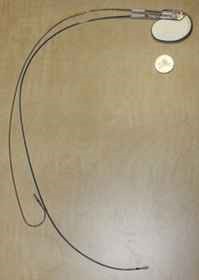
Pacemakers are devices that help to stabilise the heart’s rhythm and are usually implanted into the heart when the heart rate is too slow.
The pacemaker device comprises of 2 parts:
Pacemakers are:
There are now "leadless" pacemakers without wires , that are used mainly in patients with no/limited vascular access.
Most patients notice an improvement in their conditions and symptoms after the insertion of a pacemaker.
Sometimes, pacemakers are implanted for patients with severe heart failure (see "Cardiac Resynchronisation Therapy") to improve their heart function.
Excessively slow heart rhythms can severely affect the heart's ability to pump blood throughout the body. This may cause symptoms such as:
In such cases, your doctor may recommend a permanent pacemaker to be implanted.
Though the procedure itself only takes about an hour, you will need to stay in hospital for one day for the pacemaker implantation.
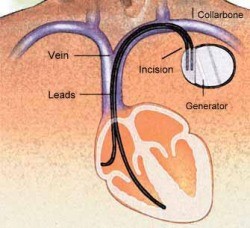
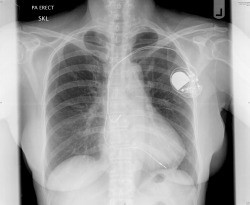
On returning to the ward,
On the following day,
On returning home,
The risks associated with the procedure are very low.
These include:
You should watch for fever, excessive pain, redness or swelling over the wound. Inform your doctor immediately if you have these symptoms.
Avoid excessive movement of the arm on the side of the pacemaker insertion. Avoid lifting the arm above your head and lifting more than 5 kg load for 2 weeks after the implantation.
Complete the course of antibiotic medication prescribed on discharge.
Remember to inform all your attending doctors that you have a permanent pacemaker. Some important reasons for this include:
If you have any queries regarding anything about the procedure or how to take care of yourself after the procedure, please contact your doctor.
These are used when patients are deemed to be at very high risk of sudden cardiac death from lethal heart rhythm disorders (arrhythmias).
These sophisticated devices monitor the heart rhythm continuously and attempt to terminate these life-threatening rhythm disorders if they occur.
This can be through rapid pacing or delivery of an electrical shock to "reset" the heart to normal rhythm.
They are implanted the same way as pacemakers.
These are small devices inserted under the skin on the chest wall to monitor a patient's heart rhythm for prolonged periods of time (up to about 3 years).
They do not have any wires and may be used in certain situations such as recurrent fainting spells where a heart rhythm disorder is suspected as the cause but not documented previously.
The left atrial appendage is an outpouching structure connected to the left atrium of the heart (left upper heart chamber). This is a normal heart structure and does not cause problems for most people. However, it can be a source of clot formation in patients with atrial fibrillation (AF).
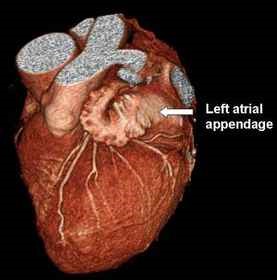
The occurrence of AF in Singapore is approximately 1.5% (that is 1.5% of Singaporeans may have AF) but this is likely to increase as the population ages. It is the most common significant type of irregular heart rhythm in Singapore but most importantly, it is the biggest risk factor causing stroke.
During AF, there is ineffective blood flow in the upper heart chambers leading to stagnation of blood in the left atrium. It has been shown that the majority of blood clots in patients with AF reside in this left atrial appendage.
Current evidence shows that the transcatheter left atrial appendage device closure is effective in reducing the risk of clot related complications associated with non-valvular causes of AF.
Though there are a variety of options available to reduce the risks of stroke in patients with AF, there is no single option that would be appropriate for every patient.
Your doctor will discuss these options with you and advice you on the option that is best suited for your condition. There are however several standard therapeutic options that you should be aware of. These include:
This is a procedure where devices designed specifically to fit the left atrial appendage is delivered through a long, thin tube (catheter) to seal the orifice of the atrial appendage.
With time, tissue growth around and over the device will occur preventing further clot formation and migration.
This procedure is done under general anesthetic in a heart catheterisation laboratory.
It takes approximately 1-2 hours.
Transesophageal echocardiogram (a type of ultrasound for the heart) and fluoroscopy (a special X-ray using dye) are used to monitor the procedure.
A soft catheter (tube) is first introduced into the leg vein and then positioned across the atrial septum.
The left atrial appendage closure device is then delivered to its intended position and released.
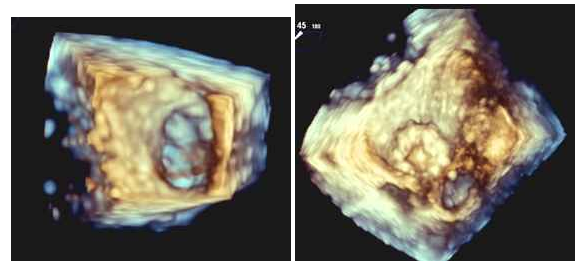
There are certain potential risks associated with any interventional procedure as well as risks specific to the device. Your doctor is the best person to provide you with accurate information and assessment of these risks. You should speak to him/her to address your concerns fully.
Potential risks include but are not limited to: